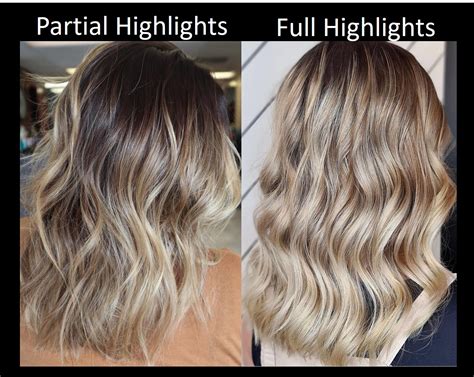Understanding the Difference
Hair highlighting has become an indispensable technique for adding depth, dimension, and vibrancy to hairstyles. Two prominent methods stand out: partial and full highlights. Each approach offers distinct benefits and considerations, catering to different hair goals and lifestyles.

Partial Highlights
What it is:
Partial highlights involve strategically targeting specific sections of hair, such as around the face, the crown, or the ends. This technique creates subtle, natural-looking highlights that enhance hair’s texture and add movement without overwhelming the overall color.
Benefits:
* More natural: Mimics the sun-kissed highlights that occur naturally.
* Less maintenance: Requires less frequent touch-ups compared to full highlights.
* Ideal for low-maintenance lifestyles: Suited for those who prefer a less dramatic look that can be blended with their natural hair color over time.
Full Highlights
What it is:
Full highlights involve applying highlights throughout the entire head of hair. This technique creates a more noticeable and even distribution of color, resulting in a bolder, more vibrant look.
Benefits:
* Dramatic transformation: Offers a complete change from the natural hair color, creating a bold and eye-catching effect.
* Suits all hair types: Enhances the texture and dimension of both fine and thick hair.
* Versatile: Allows for customization, with varying levels of brightness and contrast to achieve desired results.
Choosing the Right Technique for You
The choice between partial and full highlights depends on several factors, such as:
Hair goals:
* Partial highlights: Enhance natural highlights, add depth and dimension.
* Full highlights: Dramatic transformation, bold and vibrant look.
Lifestyle:
* Partial highlights: Less maintenance, suitable for low-key lifestyles.
* Full highlights: Requires more frequent touch-ups, ideal for those who prefer a more noticeable look.
Hair type and condition:
* Partial highlights: Suitable for all hair types and conditions.
* Full highlights: Can highlight damage in weak or over-processed hair.
Step-by-Step Guide to Partial Highlights
Materials:
* Highlight brush
* Hair clips
* Hydrogen peroxide developer
* Hair bleach
* Toner (optional)
Instructions:
1. Section hair into small, manageable parts.
2. Apply clips to isolate target areas for highlighting.
3. Mix hydrogen peroxide developer with hair bleach, following manufacturer’s instructions.
4. Use a highlighting brush to apply the mixture to desired sections, avoiding roots.
5. Process for recommended time, checking regularly for desired level of lift.
6. Rinse thoroughly with cool water.
7. Apply toner to achieve desired tone (optional).
Step-by-Step Guide to Full Highlights
Materials:
* Highlight cap
* Hair clips
* Hydrogen peroxide developer
* Hair bleach
* Toner (optional)
Instructions:
1. Put on the highlight cap, securing it with clips.
2. Use a metal hook to pull strands of hair through the perforations in the cap.
3. Mix hydrogen peroxide developer with hair bleach, following manufacturer’s instructions.
4. Apply the mixture to the strands protruding from the cap, avoiding roots.
5. Process for recommended time, checking regularly for desired level of lift.
6. Rinse thoroughly with cool water.
7. Apply toner to achieve desired tone (optional).
Common Mistakes to Avoid
- Overprocessing: This can damage hair and lead to breakage and discoloration.
- Using incorrect developer strength: Can result in insufficient or excessive lightening.
- Touching up too often: Can weaken hair and lead to premature breakage.
- Ignoring maintenance: Regular appointments are crucial to maintain the integrity and vibrancy of highlights.
Innovative New Application: “Hairpainting”
Pushing the boundaries of traditional highlighting techniques, “hairpainting” offers a creative approach that combines the precision of partial highlights with the artistry of full highlights. By using a painting tool instead of a highlighting brush, hairpainters can create freehand patterns, blending colors and tones to achieve unique and personalized looks.
Tables for Further Insights
| Highlighting Technique | Natural-Looking | Dramatic Transformation | Maintenance | Hair Type |
|---|---|---|---|---|
| Partial Highlights | Yes | No | Low | Suitable for all |
| Full Highlights | No | Yes | High | Enhances all types |
| Hair Type | Partial Highlights | Full Highlights |
|---|---|---|
| Fine hair | Adds volume and dimension | Can be too harsh, avoid roots |
| Thick hair | Highlights texture and movement | Enhances richness and depth |
| Damaged hair | Avoid, can worsen damage | Can be used with caution, avoid overprocessing |
| Over-processed hair | Avoid, can lead to breakage | Avoid, can exacerbate damage |
| Lifestyle Considerations | Partial Highlights | Full Highlights |
|---|---|---|
| Busy schedule | Less maintenance appointments | Requires more frequent touch-ups |
| Low-key lifestyle | Subtle enhancement, blends with natural hair | Can be too noticeable for some |
| Frequent social events | Requires touch-ups to maintain vibrancy | Dramatic look can be attention-grabbing |
| Formal occasions | Enhances sophistication and elegance | Can create a more polished appearance |
| Coloring Goals | Partial Highlights | Full Highlights |
|---|---|---|
| Natural enhancement | Subtle dimension, mimics sun-kissed highlights | Complete transformation, bold and vibrant |
| Corrective coloring | Can correct brassiness or uneven tones | Can be used to cover gray or unwanted colors |
| Fashion statement | Create trendy and edgy looks | Dramatic and eye-catching |
| Personal style | Enhances existing hair color, adds texture | Creates a new and bold look |
